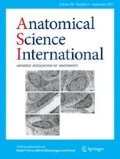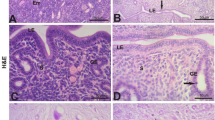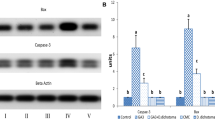Abstract
Gibberellic acid (GA3), a plant growth regulator, is widely used in agriculture in many countries to accelerate the growth of fruits and vegetables. We designed histological, immunohistochemical, and biochemical studies to evaluate the deleterious effects of GA3 on the livers of adult pregnant rats and their offspring and to assess the possible ameliorative effect of Nigella sativa Linn. (NsL.oil) against these effects. Twenty-four pregnant albino rats were utilized, randomly divided into four groups: The first group was used as a negative control group, while the second group (positive control group) was provided NsL.oil at a dose of 100 mg/kg of bodyweight. Animals in the third group (GA3 group) were provided 200 ppm of GA3 dissolved in distilled water from the 7th day of pregnancy until 1 day after delivery. Animals in the last group (GA3 + NsL.oil group) were provided GA3 and NsL-oil at the same doses as mentioned above. One day after delivery, each group of lactating mothers and their pups were sacrificed. Liver specimens were subjected to histopathological, immunohistochemical, and biochemical examinations. The livers of rats from the GA3 group showed various degenerative changes, being predominant in the livers of the mothers compared with the offspring. The pathological changes in the livers of the offspring suggested transplacental passage of GA3. The results reveal that GA3 ingestion induced a significant increase in alanine aminotransferase (ALT) and aspartate transaminase (AST) activities in the serum of both groups of mothers and their pups, with a significant increment in lipid peroxidation as evidenced by enhanced malondialdehyde (MDA) levels with significant decrements in superoxide dismutase (SOD), catalase (CAT), and glutathione peroxidase (GPx) enzymatic activities in comparison with control groups in the liver of mothers and their offspring. Histopathological examination showed hydropic degeneration and inflammatory cellular infiltration. Additionally, there was fibrosis around the portal area. Moreover, immunolocalization revealed downregulation of the expression of the antiapoptotic marker Bcl-2 in hepatocytes and upregulation of the expression of the apoptotic marker Bax in the treated group. Concomitant use of NsL.oil along with GA3 exerted a considerable reversing effect on histopathological and biochemical changes in the livers of mother groups and their pups. The results of the present study highlight the consequences of exposure to GA3 during pregnancy on hepatic tissue in both mothers and their offspring. Furthermore, the study suggests use of NsL.oil as a potential protective strategy against GA3-induced liver toxicity.













Similar content being viewed by others
Abbreviations
- GA3:
-
Gibberellic acid
- NsL.oil:
-
Nigella sativa Linn.
- MDA:
-
Malondialdehyde
- SOD:
-
Superoxide dismutase
- CAT:
-
Catalase
- GPx:
-
Glutathione peroxidase
- AST:
-
Aspartate aminotransferase
- ALT:
-
Alanine aminotransferase
References
Abd El Azim BH (2017) Toxicological study of gibberellic acid on liver, kidney and brain and its apostasy in adult abino rats. R J Pharm Biol Chem Sci 8(5):443–450
Abd El-Latief HH (2016) Hepatotoxicity induced by gibberellic acid (GA3) in adult male rats. Int J Adv Res 4:2677–2687
Abdelhamid AM, Dorra TM, Ali MA, Abou-Egla EH (1994) Effect of gibberellic acid on broiler chickens performance and some metabolic parameters. Arch Anim Nutr 46(3):269–276
Aebi H (1974) Methods of enzymatic analysis, 2nd edn., vol 2, pp 673–678. Verlag Chemie, Weinheim
Al-Azemi M, Omu FE, Kehinde EO, Anim JT, Oriowo MA, Omu AE (2010) Lithium protects against toxic effects of cadmium in the rat testes. J Assist Reprod Genet 27:469–476
Alenzi FQ, AlsakranAltamimi MA, Kujan O, Tarakji B, Tamimi W, Bagader O, Al-Swailmi F (2013) Antioxidant properties of Nigella sativa. J Mol Genet Med 7:1747-0862
Ali BH, Blunden G (2003) Pharmacological and toxicological properties of Nigella sativa L. Phytother Res 17:299–305
Alison MR, Poulsom R, Forbes SJ (2001) Update on hepatic stem cells. Liver 21:367–373
Alshawsh MA, Abdulla MA, Ismail S, Amin ZA (2011) Hepatoprotective effects of Orthosiphon stamineus extract on thioacetamide-induced liver cirrhosis in rats. Evidence-Based Complementary and Alternative Medicine
Arous S, Boussaid M, Marrakchi M (2001) Plant regeneration from zygotic embryo hypocotyls of Tunisian chili (Capsicum annuum L.). J Appl Hortic 3:17–22
Bancroft J, Layton C (2013) The hematoxylin and eosin. In: Suvarna SK, Layton C, Bancroft JD (eds) Theory and practice of histological techniques, 7th edn. Churchill Livingstone of Elsevier, Philadelphia, pp 172–214 (Ch. 10 and 11)
Barakat MK, Oda NR, Bayoumy FA, Bayoumy FA (2010) Effect of Nigella sativa on carbon tetrachloride and paracetamol induced hepatotoxicity: role of antioxidant enzymes and cytokines
Bauer M, Schuppan D (2001) TGF beta1 in liver fibrosis: time to change paradigms? FEBS Lett 502:1–3
Bekheet SH, Awadalla EA, Salman MM, Hassan MK (2011) Bradykinin potentiating factor isolated from Buthus occitanus venom has a protective effect against cadmium-induced rat liver and kidney damage. Tissue Cell 43:337–343
Boğa A, Binokay S, Sertdemir Y (2009) The toxicity and teratogenicity of gibberellic acid (GA3) based on the frog embryo teratogenesis assay-Xenopus (FETAX). Turk J Biol 33:181–188
Bourgou S, Pichette A, Marzouk B, Legault J (2012) Antioxidant, anti-inflammatory, anticancer and antibacterial activities of extracts from Nigella sativa L. (black cumin) plant parts. J Food Biochem 36:539–546
Brunt EM (2000) Grading and staging the histopathological lesions of chronic hepatitis: the Knodell histology activity index and beyond. Hepatology 31(1):241–246
Celik I, Tuluce Y, Turker M (2006) Antioxidant and immune potential marker enzymes assessment in the various tissues of rats exposed to indoleacetic acid and kinetin: a drinking water study. Pest Biochem Physiol 86:180–185
Celik I, Turker M, Tuluce Y (2007) Abscisic acid and gibberellic acid cause increased lipid peroxidation and fluctuated antioxidant defense systems of various tissues in rats. J Hazard Mater 148:623–629
El-Beltagi EM, Elwan WM, El-Bakry NA, Salah EF (2017) Histological and immunohistochemical study on the effect of gibberellic acid on the seminiferous tubules of testis of adult albino rat and the possible protective role of grape seeds proanthocyanidin extract. Tanta Med J 45:79
Elkhateeb A, El Khishin I, Megahed O, Mazen F (2015) Effect of Nigella sativa Linn oil on tramadol-induced hepato- and nephrotoxicity in adult male albino rats. Toxicol Rep 2:512–519
El-sayed HI, Abo Egla MH, Mortada MM, Ramadan MM, Elbeeh ME (2012) Evaluation of acute toxicity and teratogenic effects of some plant growth regulators on albino rat embryo. J Plant Prot Pathol 3:905–919
Erin E, Afacan B, Ersony Y, Ercan F, Blaci MK (2008) Gibberellic acid, a plant growth regulator increase mast cell requirement and alters substance P levels. Toxicology 245:75–81
Garcia J, Carabano R, de Blas C (1999) Effect of fiber source on cell wall digestibility and rate of passage in rabbits. J Anim Sci 77:898–905
Gartner L, Hiatt J (2007) Colour textbook of histology, 3rd edn. Saunders Elsevier, Philadelphia, pp 422–430
Gibson-Corley KN, Olivier AK, Meyerholz DK (2013) Principles for valid histopathologic scoring in research. Vet Pathol 50(6):1007–1015
Halliwell B, Gutteridge JMC (1998) Free radicals in biology and medicine, 3rd edn. Clarendon, Oxford
Hao Q et al (2016) Resveratrol attenuates acute kidney injury by inhibiting death receptor mediated 473 apoptotic pathways in a cisplatin-induced rat model. Mol Med Rep 14:3683–3689
Hassan HA, Al-Rawi MM (2013) Grape seeds proanthocyanidin extract as a hepatic-reno-protective agent against gibberellic acid induced oxidative stress and cellular alterations. Cytotechnology 65(4):567–576
Hockenbery D, Nunez G, Milliman C, Schreiber RD, Korsmeyer SJ (1990) Bcl-2 is an inner mitochondrial membrane protein that blocks programmed cell death. Nature 348:334–336
Hussein WF, Farahat FY, Abass MA, Shehata AS (2011) Hepatotoxic potential of gibberellic acid (GA3) in adult male albino rats. Life Sci J 8:373–383
Institutional Animal Care and Use Committee (IACUC), Office of Research Compliance (ORC) (2013) https://research.iu.edu/doc/compliance/animal-care/bloomington/iub-biacuc-non-pharmaceutical-and-pharmaceutical-grade-compounds-in-research-animals.pdf
Izunya AM, Nwaopara AO, Odike MAC, Oaikhena GA, Bankole JK (2010) Histological effects of oral administration of artesunate on the liver in Wistar rats. Res J Appl Sci Eng Technol 2(4):314–318
Kannan K, Jain SK (2000) Oxidative stress and apoptosis. Pathophysiology 7:153–163
Lutterodt H, Luther M, Slavin M, Yin JJ, Parry J, Gao JM et al (2010) Fatty acid profile, thymoquinone content, oxidative stability, and antioxidant properties of cold-pressed black cumin seed oils. LWT Food Sci Technol 43:1409–1413
Marcondes FK, Bianchi FJ, Tanno AP (2002) Determination of the estrous cycle phases of rats: some helpful considerations. Braz J Biol 62(4A):609–614
Masugi Y, Abe T, Tsujikawa H, Effendi K, Hashiguchi A, Abe M et al (2018) Quantitative assessment of liver fibrosis reveals a nonlinear association with fibrosis stage in nonalcoholic fatty liver disease. Hepatol Commun 2(1):58–68
Matsumoto H, Wada T, Fukunaga K, Yoshihiro S, Matsuyama H et al (2004) Bax to Bcl-2 ratio and Ki-67 index are useful predictors of neoadjuvant chemoradiation therapy in bladder cancer. Jpn J Clin Oncol 34:124–130
Michalopoulos G (2010) Liver regeneration after partial hepatectomy. Am J Pathol 176:2–13
Moss DW, Handerson AR (1999) Clinical enzymology. In: Burtis CA, Ashwood FR (eds) Tietz textbook of clinical chemistry, 3rd edn. W.B. Saunders, Philadelphia, pp 617–721
Nishikimi M, Rao N, Yogi K (1972) Colorimetric determination of super oxide dismutase. Biochem Biophys Res Commun 46:849–854
Ohkawa H, Ohishi N, Yagi K (1979) Assay for lipid peroxides in animal tissues by thiobarbituric acid reaction. Anal Biochem 95:351–358
Orrenius S, Zhivotovsky B, Nicotera P (2003) Regulation of cell death: the calcium apoptosis link. Nat Rev Mol Cell Biol 4:552
Ozturk F, Gul M, Ates B, Ozturk IC, Cetin A, Vardi N et al (2009) Protective effect of apricot (Prunus armeniaca L.) on hepatic steatosis and damage induced by carbon tetrachloride in Wistar rats. Br J Nutr 102(12):1767–1775
Pan HZ, Zhang H, Chang D, Li H, Sui H (2008) The change of oxidative stress products in diabetes mellitus and diabetic retinopathy. Br J Ophthalmol 9(2):548–551
Pommier Y, Fesen MR, Goldwasser F (1996) Topoisomerase II inhibitors: the epipodophyllotoxins, m-AMSA and the ellipticine derivatives. In: Chabner BA, Longo DL (eds) Cancer chemotherapy and biotherapy, 2nd edn. Lippincott-Raven, Philadelphia, pp 435–461
Rahman I, Mcnee W (2000) Oxidative stress and regulation of glutathione in lung inflammation. Eur Respir J 16(3):534–554
Reel B, Guzeloglu M, Bagriyanik A, Atmaca S, Aykut K, Albayrak G, Hazan E (2013) The effects of PPAR-γ agonist pioglitazone on renal ischemia/reperfusion injury in rats. J Surg Res 182(1):176–184
Reitman S, Frankel S (1957) A colorimetric method for the determination of serum glutamic oxalacetic and glutamic pyruvic transaminases. Am J Clin Pathol 28(1):56–63
Robbins SL, Angell M, Kumar V (1981) Basic pathology, 3rd edn, pp 17–18. Saunders, Philadelphia
Ross M, Pawlina W (2006) “Histology”: a text and atlas with correlated cell and molecular biology, 5th edn. Lippincott Williams & Wilkins, Philadelphia, pp 576–584
Sakr SA, Okdah YA, El-Abd SF (2003) Gibberellin A3 induced histological and histochemical alterations in the liver of albino rats. Sci Asia 29:327–331
Sastry PS, Rao KS (2000) Apoptosis and the nervous system. J Neurochem 74:1–20
Thomas L (1998) Alanine aminotransferase (ALT), Aspartate aminotransferase (AST). Clinical laboratory diagnostics, 1st edn, vol 2, pp 55–56. TH-Books Verlagsgesellschaft, Frankfurt
Troudi A, Mahjoubi SA, Zeghal N (2009) Hepatotoxicity induced by gibberellic acid in adult rats and their progeny. Exp Toxicol Pathol 18:127–133
Troudi A, Samet AM, Zeghal N (2010) Hepatotoxicity induced by gibberellic acid in adult rats and their progeny. Exp Toxicol Pathol 62:637–642
Troudi A, Amara IB, Soudani N, Samet AM, Zeghal N (2011) Oxidative stress induced by gibberellic acid on kidney tissue of female rats and their progeny: biochemical and histopathological studies. J Physiol Biochem 67:307–316
Tuluce Y, Celik I (2006) Influence of subacute and subchronic treatment of abscisic acid and gibberellic acid on serum marker enzymes and erythrocyte and tissue antioxidant defense systems and lipid peroxidation in rats. Pest Biochem Physiol 86:85–92
Valentine PW (1967) Studies on the quantitative and qualitative characterization of erythrocyte glutathione peroxidase. J Lab Clin Med 70:158–170
Varghese F et al (2014) IHC Profiler: an open source plugin for the quantitative evaluation and automated scoring of immunohistochemistry images of human tissue samples. PLoS One 9:e96801
Vozarova B, Stefan BN, Lindsay SR, Saremi A, Pratley ER, Bogardus C, Tatarnni AP (2002) High alanine aminotransferase is associated with decreased hepatic insulin sensitivity and predicts the development of type 2 diabetes. Diabetes 51:1889–1895
World Health Organization (WHO) & United Nations Environment Programme (1990) Public health impact of pesticides used in agriculture. World Health Organization. http://www.who.int/iris/handle/10665/39772
Wolter KG, Hsu YT, Smith CL, Nechushtan A, Xi XG, Youle RJ (1997) Movement of Bax from the cytosol to mitochondria during apoptosis. J Cell Biol 139:1281–1292
Worthen DR, Ghosheh OA, Crooks PA (1998) The in vitro anti-tumor activity of some crude and purified components of blackseed, Nigella sativa L. Anticancer Res 18:1527–1532
Zhang LY, Wang CX (1984) Histopathological and histochemical studies on the toxic effect of brodifacoum in mouse liver. Acta Acad Med Sci 6:386–388
Funding
This study was not funded by any source
Author information
Authors and Affiliations
Contributions
All authors made equal contributions to this study.
Corresponding author
Ethics declarations
Conflict of interest
The author(s) declare that there are no potential conflicts of interest with respect to the research, authorship, and/or publication of this article.
Additional information
Publisher's Note
Springer Nature remains neutral with regard to jurisdictional claims in published maps and institutional affiliations.
Rights and permissions
About this article
Cite this article
Alsemeh, A.E., Moawad, R.S. & Abdelfattah, E.R. Histological and biochemical changes induced by gibberellic acid in the livers of pregnant albino rats and their offspring: ameliorative effect of Nigella sativa. Anat Sci Int 94, 307–323 (2019). https://doi.org/10.1007/s12565-019-00488-0
Received:
Accepted:
Published:
Issue Date:
DOI: https://doi.org/10.1007/s12565-019-00488-0




